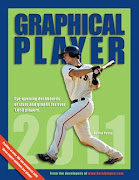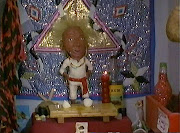 Cleveland has had a tough time finding that “second baseman of the future” ever since they shipped out Brandon Phillips in 2006. Since then, second has been occupied by Josh Barfield and various veteran journeymen. Ronnie Belliard’s tenure, from 2004 until he was traded to St. Louis late in 2006, was the longest of the bunch. Belliard also posted two of the best offensive seasons (106, 107 OPS+) by a Cleveland second baseman since Roberto Alomar in 2001 (150 OPS+), so clearly it’s been a while since the franchise had a capable hitter manning the pivot.
Cleveland has had a tough time finding that “second baseman of the future” ever since they shipped out Brandon Phillips in 2006. Since then, second has been occupied by Josh Barfield and various veteran journeymen. Ronnie Belliard’s tenure, from 2004 until he was traded to St. Louis late in 2006, was the longest of the bunch. Belliard also posted two of the best offensive seasons (106, 107 OPS+) by a Cleveland second baseman since Roberto Alomar in 2001 (150 OPS+), so clearly it’s been a while since the franchise had a capable hitter manning the pivot.This makes a player like Luis Valbuena all the more intriguing. Valbuena was acquired from Seattle (along with Joe Smith via the Mets) during the 2008 offseason in exchange for Franklin Gutierrez. Even though Cleveland essentially pulled a Brian Giles with the Gutierrez trade (stud outfielder traded so he wouldn’t be blocked by a studlier outfielder at his natural position), the expectations within the organization and amongst the fans (at least those who valued cost-controlled, elite defenders in center field) were already slightly elevated. The fact that the Barfield trade ended up as a huge disappointment also shadowed Valbuena’s arrival.
Despite a rushed development track with Seattle, the 22-year-old Valbuena more than held his own in the upper minors, splitting the 2008 season between Double and Triple-A. After posting a combined .303/.382/.431 line over 523 PA that year, Cleveland promoted him full time to Triple-A, where he continued to thrive at the plate with a .321/.436/.538 line over 95 PA. Valbuena made his debut in Cleveland in May of 2009 and proceeded to take his lumps against major league pitching for the remainder of the season. The Tribe had wanted to determine if he could be a viable starter as the team shifted into rebuilding mode and expressed optimism in the relatively raw Valbuena’s .714 OPS that season.
Valbuena received a vote of confidence from new manager Manny Acta during spring training this offseason when Acta addressed the topic no young position player wants to be associated with:
We're not in the business of developing platoon players at 24 years old. We're going to give him opportunities [against lefties].
From a developmental stand-point, this was the right approach to take with Valbuena. Common sense dictates that he’ll never figure out lefties if he doesn’t get a chance to face them on a regular basis. However, there have been rumblings that Acta may be hedging somewhat on his original promise. Below are the season splits for Valbuena and his backup, Mark Grudzielanek, through May 1:
Valbuena
| Split | GS | PA | 2B | HR | BB | OBP | SLG | OPS | BABIP |
| Total | 16 | 65 | 2 | 2 | 9 | .308 | .327 | .635 | .216 |
| vs RHP | 14 | 55 | 2 | 1 | 7 | .291 | .277 | .568 | .219 |
| vs LHP | 2 | 10 | 0 | 1 | 2 | .400 | .625 | 1.025 | .200 |
Grudzielanek
| Split | GS | PA | 2B | HR | BB | OBP | SLG | OPS | BABIP |
| Total | 7 | 30 | 0 | 0 | 0 | .233 | .233 | .467 | .269 |
| vs RHP | 2 | 9 | 0 | 0 | 0 | .222 | .222 | .444 | .250 |
| vs LHP | 5 | 21 | 0 | 0 | 0 | .238 | .238 | .476 | .278 |
It may be a limited sample, but considering five of Grudzielanek’s seven starts have come against LH starting pitchers (all of which were at 2B) while only two of Valbuena’s sixteen have come against lefty starters, there appears to be a trend forming. It’s too early to draw any useful conclusions performance-wise, but it is curious that Valbuena’s 10 PA against lefties this season have been outstanding while Grudzielanek’s contributions in that department have been poor.
Acta may be trying to help Valbuena break out of his early slump by putting him in ideal situations for success and will end the platoon once Valbuena gets his overall numbers up. Acta may also be feeling the pressure of managing an under-performing offense and has opted to temporarily shelve his plan for Valbuena in an effort to get some extra production from second base.
If that’s the case, it’s not working. Grudzielanek has been a dog at the plate so far, even worse than Valbuena’s overall numbers. So why not just give the kid the at-bats he was promised? Acta has the green light to test his young players this season and has suggested he’ll take advantage of that opportunity, making any talk of platoons seem out of place right now.
Is it possible Acta is just ahead of the curve on Valbuena though? After all, the main contradiction between what Acta originally stated and the direction he may be taking now was based on a spring training sound bite, so the anti-platoon policy for second isn’t exactly iron clad. Valbuena’s career minor league splits are a bit discouraging. Below are his career totals and a sample of his time in the upper minors:
| Year | Age | Level | Split | AB | HR | OBP | SLG | OPS | BABIP | LD% |
| 2008 | 22 | AA | vs RHP | 170 | 8 | .374 | .524 | .898 | .326 | 18.50% |
| vs LHP | 70 | 1 | .398 | .386 | .784 | .339 | 22.20% | |||
| AAA | vs RHP | 161 | 2 | .395 | .391 | .786 | .348 | 17.70% | ||
| vs LHP | 48 | 0 | .327 | .292 | .619 | .325 | 16.70% | |||
| 2009 | 23 | AAA | vs RHP | 59 | 3 | .471 | .661 | 1.132 | .396 | 27.50% |
| vs LHP | 19 | 0 | .304 | .158 | .462 | .214 | 13.3% | |||
| Career | Minors | vs RHP | 1289 | 37 | .361 | .447 | .808 | .306 | 13.9% | |
| vs LHP | 460 | 5 | .319 | .311 | .630 | .290 | 14.60% | |||
| Career | MLB | vs RHP | 418 | 9 | .293 | .463 | .756 | .270 | 20.6% | |
| vs LHP | 58 | 3 | .302 | .390 | .692 | .292 | 19.40% |
Valbuena’s second stint in Double-A in 2007 also happens to be his best overall season in the minors. Considering he put up a better OBP against lefties than righties for the first time since A+ ball accompanied by an elevated BABIP (.339 versus a career .302), this stretch is probably more of an outlier. After being promoted to Triple-A, Valbuena’s numbers against lefties dropped off considerably and haven’t shown much sign of rebounding.
His career minor league splits reinforce this trend with a .630 OPS over 460 AB against lefties compared to a much healthier .808 OPS over 1289 AB against righties. Not only has Valbuena struggled to get on base against southpaws (.319 OBP), but his bat loses most of its pop (.311 SLG).
With that kind of track record, it’s quite possible that Valbuena never figures out how to handle lefties effectively. If he failed to do so against lesser competition throughout his minor league career, the odds don’t look good, even if he were to receive regular at-bats against them in the majors. However, the main factor working in the 24-year-old's favor at the moment is that he was rushed through the minors and is still relatively young for a major league starter, so he could still develop into a serviceable hitter against lefties down the road.
The team should maintain a patient approach with Valbuena. Regardless of what he does against lefties, it’s well established that he has the potential to be an above average hitter versus righties (which is what he’ll be facing most of the time anyway). Also, considering Valbuena’s home is second base, it’s not like he’s expected to be an integral part of the offense, nor is he blocking any superior hitters down on the farm.
A lot of players tend to have difficulty against left handed pitching during their career. For example, fellow lefty Grady Sizemore has a modest career OPS of .705 against left handed pitching, which casts Valbuena's career mark of .630 in the minors in a better light considering the disparity in talent between the two players.
Given how ineffective guys like Sizemore, Peralta, and Hafner have been early in the season, it would seem unfair to single out Valbuena’s slump. If management does decide to shake things up at second base though, Jason Donald is making quite a case for himself in Columbus with 8 doubles, 2 HR, and a .321/.424/.912 line over 84 AB so far. Donald can also play every infield position except first, meaning incumbent utility infielder Grudzielanek should start looking over his shoulder as well.
Coincidentally, Donald owns a career minor league line of .279/.391/.423 against left handed pitching, making him an ideal platoon partner for Valbuena if that’s the direction the team decides to go in. Cleveland would have to move Grudzielanek before promoting Donald, but that appears to be the best option if Grudzielanek fails to produce at the plate.
Having both Valbuena and Donald up gives Manny Acta more options as far as developing his future roster while optimizing his current one. Even if the team “is not in the business of developing 24 year old platoon players,” at least they’d be able to get a look at their two best options at second base in the same season, possibly improving the offense in the process if they end up as a pure platoon.









No comments:
Post a Comment